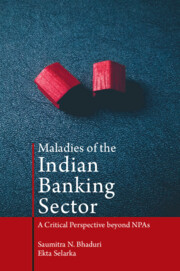Book contents
- Frontmatter
- Dedication
- Contents
- List of Figures
- List of Tables
- Foreword
- Acknowledgements
- 1 Prologue
- 2 The Indian Banking Sector: A Brief History
- 3 The Index of Credit Allocative Efficiency
- 4 Macroeconomic Analyses of Bank Credit Misallocation in the Indian Corporate Sector: Investigation of Pro-cyclicality
- 5 Determinants of Bank Credit Misallocation: Firm-level Analysis
- 6 Allocative Efficiency of Bank Credit and Firm Performance
- 7 Credit Reallocation by Indian Banks in the Aftermath of the Global Financial Crisis
- 8 The Zombie Story: Credit Boom and the Rise of Zombie Firms in the Indian Economy
- 9 Epilogue
- Bibliography
- Index
2 - The Indian Banking Sector: A Brief History
Published online by Cambridge University Press: 27 September 2022
- Frontmatter
- Dedication
- Contents
- List of Figures
- List of Tables
- Foreword
- Acknowledgements
- 1 Prologue
- 2 The Indian Banking Sector: A Brief History
- 3 The Index of Credit Allocative Efficiency
- 4 Macroeconomic Analyses of Bank Credit Misallocation in the Indian Corporate Sector: Investigation of Pro-cyclicality
- 5 Determinants of Bank Credit Misallocation: Firm-level Analysis
- 6 Allocative Efficiency of Bank Credit and Firm Performance
- 7 Credit Reallocation by Indian Banks in the Aftermath of the Global Financial Crisis
- 8 The Zombie Story: Credit Boom and the Rise of Zombie Firms in the Indian Economy
- 9 Epilogue
- Bibliography
- Index
Summary
Evolution of Banking in India
The history of banking in India goes back to the 19th century. The first bank in India – the Bank of Bengal – was set up by the British in 1809. The primary interest of this bank was to cater to the needs of the colonial government. Following this, two other presidential banks – the Bank of Bombay and the Bank of Madras – were incorporated in 1840 and 1843. However, in modern parlance, the first commercial bank was the Imperial Bank of India, which evolved by merging the three presidential banks in 1935. The first Indian-owned bank, Allahabad Bank, which is still functional, was set up in 1865 in Allahabad, followed by the establishment of another large bank in 1985 – the Punjab National Bank. The subsequent years witnessed the setting up of many banks, such as Bank of India, Central Bank of India, Canara Bank, Indian Bank, Bank of Baroda, and Bank of Mysore. As the business activities centred in urban areas, these banks were all located in urban centres.
The British had already recognized the role of banks in the economy, and the need to regulate the money supply was the core theme of the Royal Commission on Indian Currency and Finance in 1926. Before independence, the country had privately owned banks as joint-stock companies. Therefore, the areas of operation of the banks were localized. Consequently, the Reserve Bank of India Act, 1934, paved the way for establishing the Reserve Bank of India (RBI) as the central bank of India. The RBI commenced operations in April 1935 and exercised its control over other banks by setting the cash reserve ratio (CRR) and other statutory parameters for operations. Interestingly, many prominent banks collapsed in the pre-independence era (such as the Presidency Bank of Bombay, Travancore National and Quilon Bank, and Bank of Upper India). There were around 600 operational commercial banks at the time of independence in 1947. However, a marked shift in banking activities emerged shortly after Indian independence. The Government of India (GOI) started taking an active role in controlling the banking functions. The Banking Regulation Act, 1949, nationalized the RBI and made it the apex body to control, supervise, and regulate the banking activities of all the banks in the country.
- Type
- Chapter
- Information
- Maladies of the Indian Banking SectorA Critical Perspective beyond NPAs, pp. 18 - 41Publisher: Cambridge University PressPrint publication year: 2022



